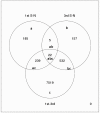Differences in gene expression between first and third trimester human placenta: a microarray study
- PMID: 22442682
- PMCID: PMC3307733
- DOI: 10.1371/journal.pone.0033294
Differences in gene expression between first and third trimester human placenta: a microarray study
Abstract
Background: The human placenta is a rapidly developing organ that undergoes structural and functional changes throughout the pregnancy. Our objectives were to investigate the differences in global gene expression profile, the expression of imprinted genes and the effect of smoking in first and third trimester normal human placentas.
Materials and methods: Placental samples were collected from 21 women with uncomplicated pregnancies delivered at term and 16 healthy women undergoing termination of pregnancy at 9-12 weeks gestation. Placental gene expression profile was evaluated by Human Genome Survey Microarray v.2.0 (Applied Biosystems) and real-time polymerase chain reaction.
Results: Almost 25% of the genes spotted on the array (n = 7519) were differentially expressed between first and third trimester placentas. Genes regulating biological processes involved in cell proliferation, cell differentiation and angiogenesis were up-regulated in the first trimester; whereas cell surface receptor mediated signal transduction, G-protein mediated signalling, ion transport, neuronal activities and chemosensory perception were up-regulated in the third trimester. Pathway analysis showed that brain and placenta might share common developmental routes. Principal component analysis based on the expression of 17 imprinted genes showed a clear separation of first and third trimester placentas, indicating that epigenetic modifications occur throughout pregnancy. In smokers, a set of genes encoding oxidoreductases were differentially expressed in both trimesters.
Conclusions: Differences in global gene expression profile between first and third trimester human placenta reflect temporal changes in placental structure and function. Epigenetic rearrangements in the human placenta seem to occur across gestation, indicating the importance of environmental influence in the developing feto-placental unit.
Conflict of interest statement
Figures



References
-
- Morrish DW, Dakour J, Li H. Functional regulation of human trophoblast differentiation. J Reprod Immunol. 1998;39:179–195. - PubMed
-
- Salafia CM, Charles AK, Maas EM. Placenta and fetal growth restriction. Clin Obstet Gynecol. 2006;49:236–256. - PubMed
-
- Aherne W, Dunnill MS. Morphometry of the human placenta. Br Med Bull. 1966;22:5–8. - PubMed
-
- Kaufmann P, Sen DK, Schweikhart G. Classification of human placental villi. I. Histology. Cell Tissue Res. 1979;200:409–423. - PubMed
-
- Jauniaux E, Jurkovic D, Campbell S, Hustin J. Doppler ultrasonographic features of the developing placental circulation: Correlation with anatomic findings. Am J Obstet Gynecol. 1992;166:585–587. - PubMed
Publication types
MeSH terms
Substances
LinkOut - more resources
Full Text Sources
Medical
Molecular Biology Databases

